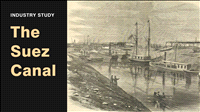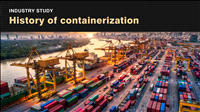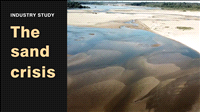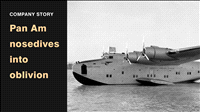History of the Suez Canal | Industry study | Business History
By Kiron Kasbekar | 13 Dec 2022
today I am going to talk about the history of the Suez Canal, the 190-km stretch of water between Europe and Asia that saved ships 70,000 km of movement around the African continent.
A manmade channel dug through the Egyptian desert a century and a half ago that remains to this day one of the most important engineering feats of the world.
In an earlier video, we looked at how containerization now dominates the world of ocean shipping. In the second half of the 1950s the world saw the launch of the first containerized cargo on ships designed to carry big steel containers stuffed with a wide variety of products that are traded around the world.
Containerization infused far greater efficiency into shipping than the world had ever known before. The turnaround time of ships got shortened compared to when ships were loaded crate by crate, package by package, bundle by bundle, and barrel by barrel – unloaded from trucks, carried by dock workers over gangplanks or hoisted by cranes, and dropped below deck into the holds of ships.
Resulting in a huge saving in time and money.
The link to our video on containerization is given in the description below. Do check it out.
Well before this trend, however, there were other developments in the world of shipping, which were set in motion in the 19th century.
These were the construction of two major artificial canals connecting two different seas in two different continental masses. These were the Suez Canal and the Panama Canal. These canals added their navigational advantages to the other main sea routes, which also used some natural straits, or channels, between seas.
Among the links in this chain of ocean shipping are five narrow straits beginning from the east and going west:
• between Malaysia and Indonesia
• between the Persian Gulf and the Gulf of Oman
• between Aden and Djibouti
• between the Red Sea and the Mediterranean Sea,
• between the Mediterranean and the Atlantic Ocean,
• between the Atlantic and Pacific oceans.
And I bet you know what they are called. But let me refresh your memory. So, the list again, with the answers:
• Malacca Straits – between Malaysia and Indonesia
• Strait of Hormuz between the Persian Gulf and the Gulf of Oman
• Bab el Mandeb (Gateway of Tears) – between Aden and Djibouti
• Suez Canal – between the Red Sea (the north-western part of the Indian Ocean) and the Mediterranean Sea,
• Strait of Gibraltar – between the Mediterranean and the Atlantic Ocean, and
• Panama Canal – between the Atlantic and Pacific oceans.
There are some less important straits besides these. I say less important only because they serve a much smaller number of countries compared to the six I’ve just listed. They have their own regional strategic importance that cannot be ignored.
Two of these, the Dardanelles, and the Bosporus, separate the European part of Turkey from its Asian part, and they have a great deal of history between them. Istanbul has played an important part in the history of Islam and, under its previous name of Constantinople, it was the centre of Christianity between 4th and 11th centuries AD. But this is not the place to talk about this region or these straits.
I am also not going to discuss the other areas – the Malacca Strait, the Hormuz Strait, the Bab-el-Mandeb, or the Strait of Gibraltar – in this video.
We shall also not discuss the Panama Canal, which was first mooted as long ago as 1513 but virtually forgotten. Bust just a few words about it. After a lack of interest for ages, and some project setbacks in the 19th century, construction began on 1 January 1881. After great difficulty and thousands of deaths, the Panama Canal was finally commissioned on 15 August 1914. This will be the subject of another video.
We’ve got so accustomed to reading about the very large shipments of petroleum products through the Suez Canal that we need to be reminded that this canal was conceptualized many decades before they discovered petroleum in the Middle East.
Remember, petroleum was first used in small quantities to light lamps in China in the fourth century AD. But it was not really an industry. There were big discoveries of petroleum in the Americas in the middle of the 19th century.
And the discovery of oil in the Middle East came much later, when a British company struck oil in Persia (as Iran was known then) in May 1908. The other big oil discovery in the region was in Saudi Arabia, and that came only in March 1938!
So the Suez Canal was clearly not built to expedite the petroleum oil trade. There were other rationales behind its creation.
One was the rapidly growing trade in commodities and manufactured products between Europe and Asia – fine textiles, silk, gold and other metals, various precious and semiprecious stones, and spices and aromatic products going from Asia to Europe, and European factory-made products like textiles and steel exported to Asia.
In ancient times, regions of Asia had commercial relations with parts of Europe and Africa. In the earliest days nomadic peoples traded over considerable distances, using barter as the method of exchange.
With the industrial revolution in Europe, there was much greater impetus for trade than there ever was before.
The other rationale was military conquest. Do remember that the purpose of military expansion was to expand and consolidate the commercial power and profits of the European traders and businessmen.
The Suez Canal would reduce the distance European traders and the armadas had to travel from their home ports to their Asian destinations.
Before the Suez Canal was created, all northern European trade had to go from as north as the British Isles, down south along the western coast of Africa, around the Cape of Good Hope in South Africa, and then up north and east again – to reach various Asian countries.
India was the most important among the destinations because of its sheer size and because of the many varied commodities and artisanal products it offered. But there was another big draw, which was China, and there were smaller magnets – Thailand, Indonesia, Malaya (what a large part of Malaysia was previously known as), and the Philippines.
The first moves for a canal between the Mediterranean and the Red Sea began when, after his military campaign in Egypt and Syria and after his becoming emperor of France, Napoleon I began toying with the idea of constructing a north-south canal to connect the Mediterranean Sea with the Red Sea.
French archaeologists, scientists, cartographers and engineers scouted northern Egypt and mapped the region. They found an ancient canal extending northward from the Red Sea and then westward toward the Nile in Egypt – not crossing over to the Mediterranean. This canal had been closed down in the year 767.
The French decided that more than a canal to the Nile, a canal from the Red Sea to the Mediterranean Sea would be very useful to them. So they mapped the entire area with the hope that a canal might be carved out of a stretch of land between the two seas.
Had it not been for some erroneous calculations, it’s likely that the French would have begun excavation for the Suez Canal a half century before the project eventually commenced.
That early plan was abandoned because the cartographers and engineers arrived at an erroneous conclusion about the terrain. They had come to believe that the Red Sea was 8.5 meters, or 28 feet higher than the Mediterranean Sea!
So they had concluded that they would have to build locks for ships to travel up and down the canal. Their belief about the height of the Red Sea waters was wrong.
Incidentally, not everyone may know what a lock means in marine navigation. This is how Wikipedia defines it:
‘A lock is a device used for raising and lowering boats, ships and other watercraft between stretches of water of different levels on river and canal waterways. The distinguishing feature of a lock is a fixed chamber in which the water level can be varied; whereas in a caisson lock, a boat lift, or on a canal inclined plane, it is the chamber itself (usually then called a caisson) that rises and falls.’
The French government decided that building such a system based on locks would be expensive and not worth their while. And, with that, the first glimmer of a plan for a canal linking the Red Sea with the Mediterranean flickered out.
But while the plan was scrapped, the idea did not die. Like all good ideas it re-surfaced after a few decades in limbo.
The basic idea behind the canal was to facilitate trade between Europe and India and other lands of Asia that were rich with commodities that the newly rich Europeans wanted, and to serve as the markets for their manufactured products. And that idea was alive and kicking!
The Suez Canal was one of those many projects initiated by European colonists to facilitate trade in goods across the world.
The Suez Canal runs through Egyptian territory; but it was not built or financed by the Egyptian government. The project to dig through the desert to create a navigable route was financed by the Suez Canal Company, a joint-stock company headquartered in Paris.
At start France had 52 per cent of the shares in the company, and Egypt held 44 per cent. By 1875, Egypt had sold its shares to Britain, which was assisting in the canal’s administration.
Now remember that this was a period of intense colonialist rivalry that later resulted in the face-off between two mutually hostile alliances in the First World War that savaged the world between 1914 and 1918.
Who were the people ranged on either side? On one side were the Central Powers – mainly Germany, Austria-Hungary, and Turkey-based Ottoman Empire – and on the other side were the Allies – mainly France, Great Britain, Russia, Italy, Japan, and, from 1917, the United States.
In this period, Hussain bin Ali, the Sharif of Mecca, revolted against the Ottoman Empire. What followed was the 1916 Battle of Mecca, which was the first city captured by his forces.
Sharif's revolt was a turning point on the south-eastern front of the world war. Hussein declared a new state, the Kingdom of Hejaz, naming himself as the Sharif of the state with Mecca as his capital. He had decided to join an alliance with the British to defend his fiefdom.
With this alliance with the local Arab sheikhs the British gained firm control of the region. For they already had considerable influence in Egypt, on the other side of the Red Sea.
Now this was the region through which naval ships as well as merchant ships had to pass – from the Mediterranean Sea via the Suez Canal and the Red Sea to the Arabian Sea and back. So the British gained a big advantage during the First World War because they could prevent German and Turkish naval ships from plying the Suez Canal.
History is replete with events that show how international treaties are made only to be broken whenever it suits some dominant powers to do so. And the Suez Canal’s history is no different. Its international status was often clouded by political trends.
In 1888, all major European powers signed the Convention of Constantinople to ensure that the canal would be open to ships of all nations in peacetime and wartime. In peacetime and wartime. That’s what the treaty said. See the words in the slide here.
Article I of the agreement (the Convention of Constantinople) said this:
‘The Suez Maritime Canal shall always be free and open, in time of peace commerce or of war, without distinction of flag.
‘Consequently, the High Contracting Parties agree not in any way to interfere with the free use of the Canal, in time of war as in time of peace.
‘The Canal shall never be subjected to the exercise of the right of blockade.’
The convention was signed by Great Britain, Germany, Austria-Hungary, Spain, France, Italy, The Netherlands, Russia and Turkey, respecting the free navigation of the Suez maritime canal. The agreement was signed at Constantinople on 29 October 1888.
The words ‘shall never be subjected to the exercise of the right of blockade were ignored more than once. There were cases of ships being denied passage during wartime, especially during World War I and World War II. Then Egypt closed the canal during the Suez Crisis of 1956-57 involving Israel, and during the Arab-Israeli War of 1967.
Well, if we ignore the wartime disruptions, we have to admit that the canal represented a very important gain for international commerce.
It’s funny how things change in unexpected ways. You just saw how a plan that was meant to cut down the distance of part of the Spice Route that connected Europe to Asia became the Oil Route, although, of course, they don’t call it that. Which is to be expected – for a much more diverse trade plies through this route than had been envisaged back in the 19th century.
Until the canal was dug and ships started plying its waters, merchant ships and armadas from countries as far north as England and Holland, and countries as relatively near as Spain and Italy, had to sail all the way south to the Cape of Good Hope, close to the southernmost point of the African continent, and then all the way back northward or northeastward to reach India or other Asian countries.
The Suez Canal allows ships to pass directly from the Mediterranean Ocean through to the Red Sea, and back. This is a great shortcut, cutting the distance between Europe and Asia by as much as 7,000 km. as they no longer have to go around Africa.
Let me try and sum up.
Unlike the Malacca Straits or the Strait of Gibraltar, and like the Panama Canal, this 120-mile, or 190-kilometre-long stretch of water called the Suez Canal, is a manmade waterway. It was cut through the Egyptian desert just as the Panama Canal was later cut through the narrow neck of land between North America and South America.
This manmade canal, which took 10 years to dig in an area that connected Africa with Asia in a seamless stretch of desert, has transformed the world since its creation a century and a half ago in 1869.
The Suez Canal may not be counted as one of the great wonders of the world, like the Pyramids or the Taj Mahal, but it is considered one of the greatest engineering achievements in human history.
What is very sad is that poorly managed explosions while blasting through rock, collapses and other such accidents took a heavy toll. As many as 120,000 laborers died during the 10-year construction period of the Suez Canal.
As far as I know there is no memorial to these dead. That is truly sad.
Today every year around 18,000 ships use the Suez Canal, now one of the busiest waterways in the world. These ships carry over 700 million tons of merchandise. And the size of ships has grown bigger and bigger over time. Some of them are 400 meters long and weigh around 240,000 tonnes.
But we’ll come to the more recent history of the Suez Canal in another video.
I hope you liked this video. I am not done with the marine industry and global shipping. There will be more in the coming weeks.




























